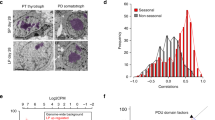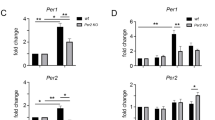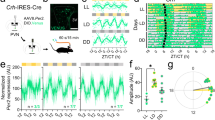Abstract
THE CREM gene1–4 encodes the transcriptional represser ICER3,5, which has been implicated in the molecular mechanisms controlling circadian rhythms in mammals4–6. ICER is rhythmically expressed in the pineal gland, with peak levels occurring at night5. ICER levels are regulated by light by means of the suprachiasmatic nucleus (SCN); transcription is induced during darkness by adrenergic input to the pineal gland from the SCN, which activates the ICER promoter using cyclic AMP and the transcriptional activator CREB. This induction is transient because ICER represses its own transcription3. Here we show that the response of the CREM gene to adrenergic stimulation is determined by night length. Depending on the photoperiod of the prior entraining cycles, the CREM gene is either subsensitive or supersensitive to induction. This differential responsiveness is controlled by the changing balance between positive (CREB) and negative (ICER) transcriptional regulators. Thus, the transcriptional response of the CREM gene is determined by the memory of past photoperiods.
This is a preview of subscription content, access via your institution
Access options
Subscribe to this journal
Receive 51 print issues and online access
$199.00 per year
only $3.90 per issue
Buy this article
- Purchase on Springer Link
- Instant access to full article PDF
Prices may be subject to local taxes which are calculated during checkout
Similar content being viewed by others
References
Foulkes, N. S., Borrelli, E. & Sassone-Corsi, P. Cell 64, 739–749 (1991).
Foulkes, N. S., Mellström, B., Benusiglio, E. & Sassone-Corsi, P. Nature 355, 80–84 (1992).
Molina, C. A., Foulkes, N. S., Lalli, E. & Sassone-Corsi, P. Cell 75, 875–886 (1993).
Sassone-Corsi, P. A. Rev. Cell dev. Biol. 11, 355–377 (1995).
Stehle, J. H. et al. Nature 365, 314–320 (1993).
Stehle, J. H., Foulkes, N. S., Pévet, P. & Sassone-Corsi, P. Molec. Endocr. 9, 706–716 (1995).
Sugden, D., Vanecek, J., Klein, D. C. & Thomas, T. P. Nature 314, 359–361 (1985).
Reiter, R. J. Endocr. Rev. 12, 151–180 (1991).
Sassone-Corsi, P. Cell 78, 361–364 (1994).
Armstrong, A., Wen, W., Meinkoth, J., Taylor, S. & Montminy, M. Molec. cell. Biol. 15, 1826–1832 (1995).
Ginty, D. D. et al. Science 260, 238–241 (1993).
Takahashi, J. Curr. Biol. 4, 165–168 (1994).
Lalli, E. & Sassone-Corsi, P. Proc. natn. Acad. Sci. U.S.A. 92, 9633–9637 (1995).
Monaco, L., Foulkes, N. S. & Sassone-Corsi, P. Proc. natn. Acad. Sci. U.S.A. 92, 10673–10677 (1995).
Yin, J. C. P. et al. Cell 79, 49–58 (1994).
Huang, Y. Y., Li, X. C. & Kandel, E. R. Cell 79, 69–79 (1994).
Bourtchuladze, R. et al. Cell 79, 59–68 (1994).
Foulkes, N. S., Schlotter, F., Pévet, P. & Sassone-Corsi, P. Nature 362, 264–267 (1993).
Deguchi, T. & Axelrod, J. Proc. natn. Acad. Sci. U.S.A. 69, 2208–2211 (1972).
Deguchi, T. & Axelrod, J. Proc. natn. Acad. Sci. U.S.A. 70, 2411–2414 (1973).
Axelrod, J. Science 184, 1341–1348 (1974).
Romero, J. A., Zatz, M. & Axelrod, J. J. Proc. natn. Acad. Sci. U.S.A. 72, 2107–2111 (1975).
Romero, J. A. & Axelrod, J. Science 184, 1091–1092 (1974).
Romero, J. A. & Axelrod, J. Proc. natn. Acad. Sci. U.S.A. 72, 1661–1665 (1975).
Illnerova, H. Pineal Res. Rev. 6, 173–217 (1988).
Illnerova, H. in Circadian Rhythms in the Mammalian Pineal Gland 1–105 (Academia, Prague, 1986).
Illnerova, H. & Vanecek, J. J. pineal Res. 2, 67–78 (1985).
Coon, S. L. et al. Science 270, 1681–1683 (1995).
Borjigin, J., Wang, M. M. & Snyder, S. H. Nature 378, 783–785 (1995).
Sumovà, A., Travnickovà, Z., Peters, R., Schwartz, W. J. & Illnerovà, H. Proc. natn. Acad. Sci. U.S.A. 92, 7754–7758 (1995).
Author information
Authors and Affiliations
Rights and permissions
About this article
Cite this article
Foulkes, N., Duval, G. & Sassone-Corsi, P. Adaptive inducibility of CREM as transcriptional memory of circadian rhythms. Nature 381, 83–85 (1996). https://doi.org/10.1038/381083a0
Received:
Accepted:
Issue Date:
DOI: https://doi.org/10.1038/381083a0
This article is cited by
-
Acute restraint stress modifies the heart rate biorhythm in the poststress period
Scientific Reports (2019)
-
CRE DNA binding proteins bind to the AP-1 target sequence and suppress AP-1 transcriptional activity in mouse keratinocytes
Oncogene (1999)
-
Signal transduction molecules in the rat pineal Organ: Ca2+, pCREB, and ICER
Naturwissenschaften (1996)
Comments
By submitting a comment you agree to abide by our Terms and Community Guidelines. If you find something abusive or that does not comply with our terms or guidelines please flag it as inappropriate.



